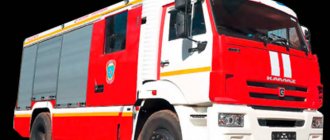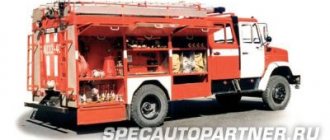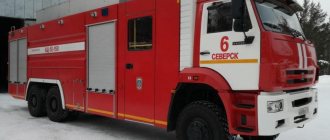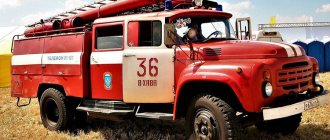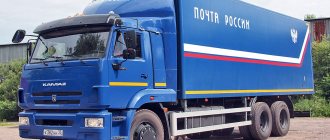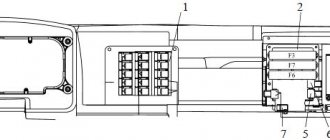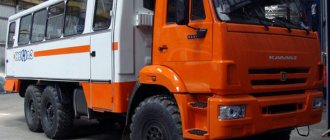- Home page »Products »Fire trucks »AC 3.2-40/4 KAMAZ 43253
ATs 3.2-40/4 on the KAMAZ 43253 chassis is designed to deliver personnel, fire extinguishing agents, fire-fighting equipment and rescue tools to the site of a fire.
Firefighting vehicles / Firefighting tankers
Fire tanker AC 3.2-40/4 (43265)
- Advantages
- Description
- Characteristics
- Corrosion-resistant materials of the tank, body, water-foam communications
- Balanced firepower supply
- Powerful pump
- High driving performance
- Remotely controlled fire monitor
- Spacious crew cabin
- Ease of maintenance
- delivery of personnel to the place of call
- extinguishing fires and carrying out emergency rescue operations using fire extinguishing agents, fire-technical weapons and emergency rescue equipment carried on it
- supplying fire extinguishing agents to the fire site from other sources, using both an independent combat unit and as a pumping unit when working “in pumping” with one or more fire trucks
| Chassis | KAMAZ 43265 |
| Wheel formula | 4x4 |
| Dimensions: length/width/height, mm | 8700/2550/3400 |
| Total weight, kg | 14500 |
| Turbocharged diesel engine | Cummins ICB6.7e5 285 |
| power, kW/hp | 209 (285) |
| Maximum speed, km/h | 90 |
| Stock of fire extinguishing agents | |
| water, l. | 3200 |
| foaming agent, l. | 200 |
| Pump (normal pressure stage) | |
| rated pump flow, l/s | 40 |
| nominal pressure, MPa | 1,0 |
| Pump (high pressure stage) | |
| rated pump flow, l/s | 4,0 |
| nominal pressure, MPa | 4,0 |
| Crew cabin type | double |
| Number of seats including driver | 6 |
© TPP Peleng LLC since 1995
This is interesting: First aid vehicle APP-1.0-40-2: description and performance characteristics
Buy KAMAZ 5387 Socage T328 4x4
KAMAZ-5387 is equipped with a hydraulic lift with a boom located behind the Socage T328 cab. The new Socage T328 auto-hydraulic lift is based on the following changes: increased horizontal boom reach to 13 meters; increased carrying capacity of the cradle up to 400 kg; the reverse principle of installation, where the cradle is located above the cabin.
The lift is installed with a folding swivel cradle. The folding principle is extremely simple and convenient to use. This is, first of all, necessary to maintain the overall height of the car, which according to regulations should not exceed 4 meters.
Technical characteristics of AGP Socage T328
| AGP | Socage T328 |
| Work equipment design | Telescopic boom with cradle |
| Working lift height, m | 28 |
| Reach, m / Cradle load capacity, kg | 17,4 / 80 14 / 300 12,9/400 |
| Rotation angle, degrees. | 360 |
| Basic chassis | KAMAZ 5387 (Euro4) |
| Car model according to OTTS | Chaika-Service |
| Overall dimensions of the car, mm: | |
| - length | 8450 |
| - width | 2500 |
| - height | 3980 (with folding cradle) |
| Vehicle base, mm | 4200 |
| Wheel formula of the car | 4x4 |
| Curb weight, kg | 11450 |
| Gross vehicle weight, kg | 11900 |
| Anti-corrosion treatment of subframe | Shot blasting |
| Platform decking | Corrugated aluminum |
| Placement of electrical wiring and high-pressure hoses | Inside the boom |
| Lift operating parameters | Ambient air temperature from -40ºС to +40ºС and wind speed no more than 10 m/sec. at a height of 10m |
| Certificates | 1.Certificate of compliance with the requirements of GOST R ISO 9001-2008 2. Valid Vehicle Type Approval 3. Certificate of compliance with technical regulations on the safety of machinery and equipment (RF Government Decree No. 573 dated September 15, 2009, as amended by Russian Government Decree No. 205 dated March 24, 2011) |
Chassis Specifications
| Engine on chassis 5387-RF | |
| Model | Cummins ISLe-C340 (EURO-4) |
| Type | diesel, in-line 6-cylinder, lined cylinders |
| Volume | 8.9 l |
| Power, hp | 340 |
| Engine on chassis 5387-RA | |
| Model | Cummins ISB6.7e4 300 (EURO-4) |
| Type | diesel, in-line 6-cylinder |
| Volume | 6.7 l |
| Power, hp | 300 |
| Transmission | |
| Model | ZF9 |
| Type | manual, 9-speed |
| Tires (dual tires) | |
| Tire size | 11.00R20 |
| Single-pitch busbar option available (additional option) | |
| Tire size | 14R20 |
10% savings in operating costs compared to analogues.
Socage T328 price | |
on KAMAZ 5387-RF chassis | RUB 8,239,648.00 VAT included |
| on KAMAZ 5387-RA chassis | RUB 7,877,041.00 VAT included |
Included in the package: Cradle with electrical insulation 2000V, cradle load capacity 400 kg, platform rotation angle 360 degrees, aluminum rotating cradle, folding, with a hydraulic rotation mechanism, cradle rotation angle 90 degrees, control panel in the cradle and on the platform, manual emergency pump, hour meter, start /car engine stop from the cradle, 220V socket in the cradle, corrugated aluminum platform flooring
riatauto.ru
Performance Variations
The KamAZ-43253 chassis and the version of the car with sides have similar technical characteristics. The index assigned to the car at production is 43253-69 (G5).
The universal chassis is oriented and adapted for the installation of all kinds of special equipment. Therefore, the vehicle is often used as a truck crane, tank truck, garbage truck, concrete mixer, feed loader, etc.
The fire-fighting version of the KamAZ-43253 is in high demand, the technical characteristics of which make it possible to effectively operate in such a specific industry.
The flatbed truck as standard has a platform (5162 by 2470 mm) with sides 1425 mm high, made of sheet steel and capable of folding down. It is also possible to equip it with a steel frame and awning. This modification can be used to form a road train that uses a GKB-8350 trailer of a similar size to a truck.
Fire ladder AL-30: purpose and design description
The fire ladder al 30 is a type of rescue equipment. An irreplaceable design that can save the lives of people living in city houses. With its help, it is possible to promptly reach the places where rescue operations are taking place and provide assistance. Used for lifting loads to a height and carrying out fire fighting. The design basis includes a sliding rotary mechanism and a hydraulic drive for lifting.
The structure of the ladder depends on the chassis. The most recognized car in Russia was considered the ZIL-131 with a chassis located on a platform and a support frame. The unit contains ladder sections, a lifting and turning device, support and hydraulic mechanisms, automatic control with a negotiation device.
Lifting and turning movements are carried out when the hydraulic pump operates. The knee set is made of steel. The composition is strong, low-carbon, with a high degree of ductility. Inherent anti-corrosion properties, light in weight.
The section includes two trusses, welded together and consisting of strings and steps. Rubber pads are used to prevent slipping on intermediate steps. Attach to pipes using clamps.
The entire weight of the device and those walking on it rests on the bottom section. She is called the carrier. The lower end of the knee rests against the support arc on the lifting frame. With the participation of steel ropes, rollers and guides, the set of knees moves, at the same time having the same speed between the knees, which corresponds to the standard.
The angle of inclination is determined by a protractor located at the bottom.
Contains the following technical characteristics: the mechanisms of the ladder truck are mounted on the chassis of a ZIL-131 car, with overall dimensions of eleven thousand millimeters in length, two thousand five hundred mm in width and three thousand two hundred mm in height, a carburetor engine with a power of one hundred and fifty horsepower, with a travel speed of eighty kilometers per hour, accommodates three people, at a maximum height - the roof of a ten-story building, withstands a load at the top of one hundred and sixty kilograms, the winch drive is powered by a hydraulic motor.
The hydraulic pump operates using a drive when the car engine is turned on, and oil enters the hydraulic system. In case of failure of the main one, a spare pump is provided. The emergency hydraulic pump operates from an electric motor that generates direct current. With its help, the ladder is lowered to the state of transportation. Equipped with an alarm and locking system.
Fire tanker AC 3.2-40/(43206)
A modern fire truck with improved tactical and technical characteristics. The tanker is built on a highly cross-country Ural 43206 chassis with a 4x4 wheel arrangement.
The tank truck has powerful lighting equipment, a modern fire monitor with remote control, and convenient compartments for fire protection equipment.
A modern, ergonomic car with a cabover cab and a two-stage pump NTsPK 40/100-4/400. Manufactured on the basis of the URAL-43206-4151-81 chassis, with a 4x4 wheel arrangement and the ability to install an in-vehicle emergency call device.
- The crew cabin has mounts for breathing apparatus with compressed air for firefighters.
- In the cab, on the front panel of the driver, there is an information device with a display that displays an indication of open cab doors, compartments for fire-fighting equipment, an indication of the level of water and foam concentrate, an indication of the operating time (pump, chassis), and allows you to control special sound and light signals installed on the AC cab with duplication on the radiator grille.
- The tank and foam tank are made of polymer materials with an extended service life. Remotely controlled monitor, both from the cabin and from the pump compartment.
- The AC is equipped with a lighting mast with a pneumatic drive for lifting spotlights with a total power of 2 kW. The height of the lighting mast is 5 meters.
- Parking system for monitor and mast. Full remote control of the pumping unit, incl. from the driver's cabin.
- The fire pump has an additional cooling circuit to provide improved cooling of the base chassis engine in the summer and for additional heating of the fire extinguishing agents in the pump in the winter.
- The fire pump has an automatic foam dosing system that provides 3% and 6% foam solutions in all fire pump flow and pressure ranges.
- A combined-action pump installation allows extinguishing both with conventional weapons and with the help of high-pressure equipment that generates finely atomized water jets. To control the pumping unit, a modern control and monitoring system is used on touch screens, with a large range of automatic functions that make the operator’s work as easy as possible.
- The chassis is equipped with a front electric winch with a traction force of 6.8 tons. The chassis is equipped with an electro-pneumatic clutch drive for turning on/off the power take-off from the pump compartment and driver's cabin.
- There is a 60 m high pressure hose reel, a lighting mast, and a winch. Automatic foam mixing and water filling systemHigh corrosion resistance of the fire crew body and cabin is achieved by manufacturing them from aluminum and plastic.
- The AC superstructure is an independent structure made of aluminum sheet and plastic using adhesive technology. The roof of the superstructure is covered with a special coating that prevents slipping.
| Basic characteristics | |
| Basic chassis | URAL-43206-4151-81 |
| Wheel formula | 4x4 |
| Diesel engine | YaMZ-53623 |
| Rated power, kW (hp) | 200.7 (273) |
| Maximum speed, km/h | 85 |
| Fire crew, persons | 6 |
| Water tank volume, l | 3200 |
| Foam tank volume, l | 200 |
| Pump location | rear |
| Flow in nominal mode l/sec. | 40/4 |
| Head, m | 100/400 |
Dealer map
Our company has a wide dealer network. You can find a dealer of our products in any region of Russia.
More details
Financial services
Our company cooperates with leading leasing companies for the purchase of specialized equipment.
More details
Service and guarantees
The company guarantees service (service) for UMG products in any region of Russia and abroad through a proprietary dealer service network.
More details
Buy KAMAZ 5387 Socage DAJ-337 6x6
| Technical characteristics of AGP | |
| Lift | Socage DAJ 337 |
| Lift type | Hydraulic, Combined knee-telescopic with jib |
| Availability of jib | Mandatory presence of a jib |
| Working lift height, m | 37,0 |
| Reach, m / Cradle load capacity, kg | 19,5 / 300 21,0 / 225 23,0 / 80 |
| Rotation angle, degrees. | 700 |
| Overall dimensions of the cradle, m - length - width - depth | 2,00 0,80 1,1 |
| Material for making the cradle | Aluminum |
| Cradle insulation, Volt | 2000 |
| Cradle insulation type | Support-rod, polymer insulator |
| Anti-corrosion treatment of subframe | Shot blasting |
| Platform decking | Corrugated aluminum |
| Placement of electrical wiring and high-pressure hoses | Inside the boom |
| Transport position of the cradle | On the rear overhang |
| Type of fastening of the basket to the boom | Articulated lever |
| Angle of rotation of the basket in the horizontal plane relative to the longitudinal axis of the lift, degrees, no more | ±90 |
| Basket tilt angle, degrees | 90 |
| Time for raising the basket to working height, s | 100 |
| Section extension speed, m/s | 0,4 |
| Maximum rotation speed of the rotary part, rpm | 0,83 |
| Number of lift control panels, pcs. | 2 |
| Type of control panels: -on the AGP column -in the cradle | Manual, hydraulic, proportional Manual, electro-hydraulic, proportional |
| Operator's chair | Option |
| Support control panel | Hydraulic, proportional, 4-section (a separate section for each support), made of cast iron, has a safety valve to control the maximum pressure in the hydraulic system. An inclinometer is installed in the immediate vicinity of the support control panel - a device that monitors the horizontal position of the platform. |
| Emergency pump type: | — Electric |
| AGP security system: — Hydraulic — Electronic | The hydraulic system contains 4 safety valves necessary to limit the maximum pressure in the system in order to maintain the integrity of hydraulic components and metal structures in critical situations. Consists of the following subsystems:
|
| Support frame for AGP | Welded low alloy steel construction. Quality control of welds: using an ultrasonic flaw detector. Checking the correctness of the geometry: using a 3D scanner Leica AT 402. Shot blasting, industrial multi-layer painting system (polyacrylic, Underbody Protection anti-corrosion mastic), painting and drying in a spray booth. The color of the support frame is black (the color can be changed at the request of the client). |
| Attaching the support frame under the AGP to the chassis frame | The support frame is attached to the chassis with an elastic connection, which allows the vehicle frame to absorb torsion when driving on public roads and over rough terrain. Bolts and torque are selected according to the chassis manufacturer's instructions. |
| Other equipment |
|
| Working pressure in the hydraulic system, bar | 210-230 |
| Lift service life, years, not less | 10 |
| Temperature ranges of AGP operation | -40 to +40 degrees Celsius |
riatauto.ru
Advantages of AC 3.2-40/based on KAMAZ 43253 chassis
- The fire superstructure is made using AT technology (“Aluminum Technology”).
- The double ergonomic crew cabin (CBC) is designed for 6 people. All seats in the crew compartment of the cockpit are removable and equipped with built-in mounts for compressed air breathing apparatus (CABR) of all types. The steps and handrails of the KBR extend automatically and provide free entry and exit for the combat crew when fully equipped, including DASV.
- The elements of the superstructure (fire pump, fire monitor, steps and handrails, flashing lights, etc.) are controlled remotely by the driver from the control unit and the pump compartment through the electronic control system (LCS).
- To ensure work with removable manual fire escapes and suction hoses, there are devices for lowering and installing ladders and suction hoses.
- The AC is equipped with a centrifugal combined fire pump NH25/N25 with an automatic foam mixing system FIX-MIX complete with a high-pressure hose reel (60 m) and a NEPIRO-ERGO high-pressure spray barrel. The pumping unit is equipped with a protective heat and noise insulating casing.
- To avoid corrosion and ensure a long service life, the water tank is made of polypropylene and (or) fiberglass. The foam tank can be used for storing and transporting all types of foaming agents.
- An RM 24M monitor with manual control or an RM 25E with remote control can be installed on the roof of the AC. The productivity of the trunks is 40 l/sec at a pump pressure of 10 bar. The water jet supply range is 70 meters.
Dry vacuum test
- Enter the “WASH / DRAIN” menu and press the F5 key (vacuum test).
- To speed up the vacuum build-up, increase the pump speed by pressing the “+” key.
- When the required vacuum is reached, turn off the pump by pressing the F5 key again.
Warning! A vacuum test is carried out once every three months.
Service
The design of this car, in general, is quite thoughtful. However, some points could have been worked out more carefully. Among the obvious shortcomings that surfaced during operation, it is worth highlighting the following:
- The control unit fuse often blows - this problem is usually associated with a short circuit and is determined by the classic “ringing” using an ohmmeter.
- Diagnostic connector pinout required. Attached is a diagram.
- Not the best location of the accelerator sensor. Nothing can be done here - this is a flaw of the design engineers. Unfortunately, in our auto industry we cannot live without this.
There are other minor complaints against the manufacturers.
Design Features
Compared to its predecessor, KamAZ 43253 has some features. In particular, it is smaller in size. The chassis length is 7,425 mm, and the onboard version is 7,505 mm. Also, this truck, if necessary, is equipped with additional equipment, including such as a cross-axle differential lock and a power take-off for attachments, if any.
There are custom-made modifications that are adapted to difficult and extreme operating conditions: at ambient temperatures from -40 to +50 degrees Celsius, dust levels up to 1.5 g per 1 cubic meter.
Flatbed version and universal chassis
The universal chassis is designed for special vehicles, such as concrete mixers, truck cranes and so on. Often, within urban operating conditions, KamAZ 43253 vehicles are used in fire services and housing and communal services.
Onboard options are also quite common. The side platform has folding sides with a height of 0.73 m as standard. If the customer wishes, they can be increased. The internal dimensions of the onboard platform are 5,162 mm by 2,470 mm. At the same time, the loading height is 1,425 mm.
Cabin KamAZ 43253
All models of this manufacturer are equipped with standard cabins, which are licensed by the German concern Mercedes. They can be with a high or low roof. A sleeping place, as already noted, is not provided. At the same time, the cabin has four mounting points for the air suspension. This is very convenient from a practical and ergonomic point of view.
The driver and passenger seats are conveniently adjustable in four directions (in practice, this turns out to be quite enough); you can also adjust the steering column, both in height and inclination angle. By the way, the steering itself is equipped with an effective and truly “working” power steering.
Design and interior
The cabin uses really high-quality materials to create a feeling of comfort. The developers thought through the location of sensors, control devices, and information boards. All of them are located so as not to distract the driver from driving the vehicle.
The modern look of the truck is given by: a large windshield with three cleaning brushes, a new bumper and an original radiator grille. The hanging elements are usually painted the same color as the cabin.
This is interesting: Engineering barrier vehicle (IMR)
Basic cost 10,200,000 rubles.
For more information, use the feedback form or call: 8 (498) 540-35-35;;
Unfortunately, fires do happen, and they bring with them considerable losses, and sometimes even casualties. Firefighting equipment arriving on time to a call can save property and lives. Firefighting Services Center LLC produces custom-made modern fire engines that are reliable and have a long service life. If you want to buy special fire equipment in Moscow, then contact us.
Declaration of conformity Decision on the application for registration of a declaration of conformity
MAIN CHARACTERISTICS
| Basic chassis | KAMAZ 43253 |
| Wheel formula | 4x2 |
| engine's type | Cummins 6 ISBe 185, Euro 4 |
| Engine power | 210 hp (150 kW) |
| Combat crew | 6 |
| Water tank capacity | 3200 liters |
| Foam tank capacity | 200 liters |
| Fire pump | NH25/N25 |
| Pump capacity | 40 l/sec at 10 Atm, when the high pressure stage is operating - 4.2 l/sec at 40 Atm |
| Full mass | 15500 kg |
Buy KAMAZ UMP-400 (5387 RA Cummins ISBe 6.7 300) 4x4
Engine Cummins ISBe 300 (E4) | |
| engine's type | Diesel with pipe-supercharging |
| Number and arrangement of cylinders | 6, in-line |
| Cylinder displacement, l | 6,7 |
| Compression ratio | 17,3 |
| Maximum power, kW | 221 (300 hp) |
| Maximum torque, N*m | 1100 |
Equipment and characteristics of the UMP-400 universal engine heater on the KamAZ 5387-RF chassis | |
| Van | Metal frame made of profile pipe 40x40 mm |
| Van outer skin | Steel sheet 1.5 mm; frame – aluminum profile |
| Hatches, doors | on the right is the door for servicing the burners, behind the door for access to the spare parts box, cases for hoses - 2 pcs. |
| Service area | Fixed platform at the back of the van |
| Lighting | dome light 24V work area light 24V |
| Spare wheel holder location | On the rear overhang |
Equipment | |
| Burners | Riello RG4S (220 V) – 2 pcs. |
| Fan | BP-280-46-5 |
| Fuel tank, l | 350 |
| Number of outlets for sleeves, pcs. | 3 |
| Capacity of pencil cases for sleeves, pcs. | 10 |
| Heat exchanger | Two-section tubular made of stainless heat-resistant steel |
Specifications | |
| Maximum thermal power, kW (Gcal/h) | 400 (0,344) |
| Minimum thermal power, kW (Gcal/h) | 120 (0,1) |
| Maximum air temperature at the inlet to the hose, °C, no more | 110 |
| Efficiency, %, not less | 92 |
| Fan capacity, m3/hour | 16000 — 18000 |
| Fan pressure, Pa | 1200 — 1600 |
| Fuel | Diesel |
| Fuel consumption (for 2 burners), kg/h, no more than: | |
| starting mode | 30 |
| Work mode | 34 |
Against a fire avalanche: fire trucks
BET ON PROGRESS
Initially, SP "SP" relied on the production of machines that were not inferior to the best foreign analogues. The company's products, located on the territory of AMO ZIL, differ from other Russian competitors in their progressive technical solutions.
Today, the company’s product line includes multifunctional firefighting tankers with a capacity of 2 to 8 thousand liters on KAMAZ and MAN chassis, rescue vehicles, airfield vehicles, and a special VGSCH vehicle on the MAN TGM 13 chassis.
250 4x4 BL for transporting mountain rescue units and other types of fire equipment.
Fire and rescue vehicle AC 3.2-40/4 on KAMAZ-5387 chassis
Among the latest developments, we can note the fire and rescue vehicle AC 3.2-40/4 on the chassis (4x4) KAMAZ-5387 or MAN TGM 13.290. The cars are used both off-road and in dense city traffic.
The water tank with a capacity of 3200 liters is made of polypropylene, and the foam tank with a capacity of 200 liters is resistant to any type of foaming agent. The model is equipped with a pump with normal and high pressure stages, as well as an automatic foam mixing system complete with a high-pressure hose reel (60 m).
An electronically controlled monitor with a capacity of 40 l/s at a pressure of 10 bar is installed on the roof. The water jet supply range is 70 m.
The kit includes an electric winch with a traction force of 6 tons, LED flashing lights, rear lighting, LED lighting for the fire-fighting equipment (FTV) compartments and the front of the vehicle. Retractable footrests with anti-slip properties are used for boarding and disembarking firefighters.
The pneumatic telescopic floodlight lighting mast, resistant to wind loads up to 15 m/s, is equipped with LED spotlights.
A finder headlight on the dashboard and LED spotlights on the gallery increase the illumination radius of the work area. LED reversing lights on the mirrors improve visibility when parking at night.
There is a reversing camera with a display in the driver's cabin.
Fire pump installation
Another new product, ASA-30-0.8-0.6, is a symbiosis of a firefighter and emergency rescue vehicle. It is used to extinguish primary fires with water and foam, work in emergency zones, eliminate the consequences of road accidents and provide first aid. The model is equipped with a high-pressure pump, a crane and a winch with a traction force of up to 6.5 tons.
The 30 kVA electric power plant allows the ASA to be used as an independent power source. The volume of the water tank (800 l) and foam tank (120 l) is sufficient to quickly extinguish the fire before the arrival of the main crews. A pneumatic telescopic mast with 6 LED spotlights is installed on the roof of the machine for operation in poor visibility.
Advice
In 2022, a first aid fire truck APP-2-0.3/100 model 023-MS appeared on the UAZ-23602 (4x4) “Cargo” chassis.
The compact model, equipped with a pump and containers for liquid fire extinguishing agents, is capable of delivering personnel and fire-fighting equipment to the site of a fire (accident), extinguishing fires in the initial stage, performing priority rescue operations and providing assistance to victims. The vehicle can move on off-road roads, narrow streets, and in closed areas of suburban settlements where the access of heavy equipment is difficult.
Transmission, brakes, power supply KamAZ-5490
Fire tanker AC 5.0-100 based on KAMAZ-43118 with a pump in the cabin
Depending on the configuration, KamAZ-5490 is equipped with one of the gearboxes:
- ZF 16S 2220. The proven 16-speed manual transmission is used on many dump trucks, tractor units and chassis. The transmission consists of a four-speed gearbox, a gear divider and a range-multiplier. All forward speeds are activated using synchronizers, and rear speeds are activated using a gear clutch.
- ZF 16S 2221. A special feature of this manual gearbox is the fact that reverse gear is engaged not through the neutral position switch, but through a release valve. The box is also equipped with a multi-gear locking mechanism, which prevents erroneous gear shifts.
- ZF 12AS2130. Automatic transmission with dog clutches, equipped with a dry clutch. The design of the transmission includes a divider, a range multiplier and a three-stage main unit. The box provides a smooth start to movement and excellent acceleration dynamics, in addition, it greatly facilitates the driver’s work.
The interaction between the engine and manual transmission is carried out using a single-disc diaphragm clutch with a hydraulic drive and a pneumatic booster.
The electronic and electrical circuits and instruments of the tractor are powered by two batteries with a total capacity of 420 A/hour. The car is also equipped with a three-kilowatt generator and a voltage regulator.
Cabin design features
The truck in question is equipped with a licensed Mercedes cabin, which in the basic version does not have a berth. It is mounted on the 4-point air suspension used to equip the Mercedes-Benz Axor.
The cabin, installed on all new products of the Kama Automobile Plant since 2010, has a high level of comfort and can have a high or low roof. The original suspension design has a positive effect on the smoothness of the ride, while at the same time preventing cab sway and reducing vibrations during driving.
The position of the cabin, namely its height, is kept at a constant level, which is not affected by the degree of loading of the vehicle. The driver's seat is also equipped with pneumatics and lateral support.
The position of all seats in the cabin can be adjusted, for which four levels of adjustment are provided. This solution, coupled with the suspension of the cabin itself, provides a high level of comfort.
The steering column tilt and height adjustment function, implemented through pneumatic control, is also convenient for the driver. The steering wheel is equipped with a modern hydraulic booster.
The modernization of the truck cabin also affected its interior decoration. Thus, the quality of the materials used has increased significantly, and the plastic panels have acquired softness and pliability. The instrument panel design has become more modern. and she herself received anti-reflective glass.
The indicators, sensors and screen that are placed on it are informative and easy to read, which allows the operator to read the necessary data about the condition of the car without stopping from driving.
The plastic handles on the cabin doors received new integrated locks, as well as protection in the form of deflectors. There are fairings installed on the sides of the cabin, which are designed to reduce air turbulence and prevent contamination of the rear-view mirrors.
The latter are distinguished by new brackets where the main, curb, sliding and spherical mirrors are mounted, which guarantees the best possible visibility.
The optics of the car have also changed. Headlights, turn signals and side lights now form a single unit, providing excellent visibility and visibility. Three windshield wipers ensure the cleanness of the monolithic windshield.
The new cabin, unlike its predecessor, has a molded plastic (rather than steel) bump stop. The footrests are equipped with special pads that prevent slipping, ensuring safe lifting of the driver and passenger, regardless of weather conditions.
Transmission
(with recommendations on the most optimal gear shift modes for maximum use of the engine’s traction capabilities, for drivers to achieve the most efficient vehicle driving modes in terms of fuel consumption and vehicle performance.)
Optimal car engine speed
- When driving the car, it is necessary to control the crankshaft speed. Maximum torque is achieved at a crankshaft speed of 1300-1600 rpm.
- The vehicle may be driven only after the engine has warmed up to a coolant temperature of at least 50..55° C (yellow zone) at a crankshaft speed of 1300-1600 rpm
Attention!!!
- To prevent damage to the transmission synchronizers, the clutch should always be fully depressed.
- When switching from low to high gear and back, max. two gearbox stages. Shifting through more than two gear stages leads to wear on the gearbox synchronizers.
- To prevent damage to the transmission and engine, shift to the next lower gear only when braking has reached the maximum speed of the gear engaged.
- When working with the power take-off, under no circumstances should you change gears, as this leads to wear on the gearbox synchronizers. If changing gears is necessary to change the speed, the power take-off must be switched off before doing so.
Gear shift pattern:
Gear shift diagram
1-2-3-4-lower gears (lowest range of multiplier);
5-6-7-8-high gears (highest range of range). When slowing down, change gears only sequentially: 8-7-6-5-4-3-2-1. Always keep the gear engaged when driving
Shift gears in the gearbox using the gear shift lever located to the right of the driver's seat. Switch the lever from one position to another with the clutch disengaged. Press the clutch pedal firmly and fully. When choosing the moment to change gears, use the tachometer as a guide; after selecting a gear, you must pause for ~1 second until the gear is engaged. Change gears when:
- driving “uphill” (vehicle with full weight), switching from high to low gear at engine speed of 1400÷1600 rpm;
- driving “uphill” (vehicle with full weight), switching from low to high gear (car acceleration) should be carried out at engine speeds of 2000÷2200 rpm;
- driving on a flat surface (vehicle with full weight), switching from low to high gear (car acceleration) at engine speed of 1600÷1800 rpm.
Start driving only from first gear (to avoid premature clutch failure).
Attention!!! To prevent damage to the gearbox synchronizers, switching to the lower range of the range should only be done at speeds less than approximately 30 km/h
Advantages and disadvantages
The advantages of KAMAZ-43253 include the following features:
- Simple design. Thanks to this, it has a huge number of different modifications
- Good handling
- Good driving dynamics
- Large cargo compartment
- Increased visibility from the cab
- Maintenance on this truck is low cost
- Despite the fact that the interior has become more comfortable, relatively low-quality materials are used in its decoration.
- Truck design is outdated
- The truck has average reliability
- The truck does not meet standards to ensure the safety of the driver and passengers
Despite some shortcomings, KAMAZ 43253 is a worthy representative of the iconic truck brand. Like its predecessors, it is cheap, unpretentious, easy to operate, and also has a lot of options: from an onboard tractor to a dump truck. Thanks to these qualities, this vehicle is popular among cargo carriers in Russia and neighboring countries.
Varieties of configuration
From the very beginning, the KamAZ-5320 truck was produced in several different versions. Subsequently, many different modifications were created on its basis, including:
- Flatbed trucks;
- Truck tractors;
- Dump trucks;
- Off-road vehicles;
- Sports cars;
- Buses.
The most famous was the army all-wheel drive KamAZ-4310, however, this vehicle turned out to be almost an independent model. In “civilian” life, simpler versions were more often used, which differed from the original car mainly in their configuration.
KamAZ-5410
This modification was included in the list of basic ones that were developed at ZiL. The machine is a truck tractor, mass-produced for thirty years - from 1976 to 2006. The total weight of the road train could reach 25.9 tons. Most of these cars were equipped with a sleeper cab, and this was noticeably different from the base model.
KamAZ-5511
This car was a dump truck. The original version, KamAZ-5510, for some reason was never put into production. Unloading from the body was carried out by tipping it back. The car, like the truck tractor, was equipped with a manual transmission with a two-stage front divider, which doubled the number of gear ratios.
The installation of the dump truck on the chassis was carried out in Nizhnekamsk.
KamAZ-53212
This vehicle was a development of one of the original options - the KamAZ-53202 flatbed truck with an extended wheelbase. This model was produced from 1978 to 2000. The truck cabin is equipped with a berth, and the engine is equipped with a pre-heater, facilitating operation at low temperatures. The length of the machine has been increased to 8530 mm. In some cases, such trucks received additional equipment, the installation of which was carried out behind the cab.
It should be noted that this modification is sometimes mistakenly designated as KamAZ-53112.
KamAZ-55102
This modification, like KamAZ-5511, is a dump truck. The car was intended for transporting bulk cargo in rural areas. Unloading is possible not only by tilting the body backwards, but also to the sides - the sides are made folding. The carrying capacity is slightly lower than that of the 5511 and is 7 tons. The cabin, as a rule, did not have a sleeping place.
Weight, dimensions, load capacity
The weight and overall characteristics of the vehicle of this type are relatively small, despite its main purpose. The parameters are as follows:
- curb weight of the model without winch – 6,135 kg;
- curb weight of the model with winch is 6,375 kg.
Although, according to the technical specifications, the weight of the winch mechanism of the ZIL-131 vehicle is quite significant, its presence is always justified, since it allows you to cope with movement in extremely difficult and extreme terrain conditions.
Gross vehicle weight:
- with a winch - 10,425 kg;
- without winch - 10,185 kg.
The maximum load capacity is only 3,500 kg. Also, if necessary, the equipment in question can be used in conjunction with a trailer.
Its permissible weight depends on the road conditions in which the ZIL-131 travels:
- weight when driving on a paved road – 6,500 kg;
- when driving on a dirt road – 4,000 kg.
The basic version of the car has the following overall dimensions:
- length from the front bumper to the rear of the body, mm – 7,040;
- height without awning, mm – 2,480;
- height with awning, mm – 2,975;
- width from left wheel to right, mm – 2,500.
The ground clearance of the ZIL-131 is as much as 330 mm, which allows you to move without much difficulty even over rough terrain - in forests, fields or other similar places.
The distance between the wheels is 3.35 m +1.25 m. The width of the front and rear tracks is the same and is 1.82 m. The turning radius is as much as 10.8 m. Considering the length of the body, this parameter is not that great.
The braking distance is 29 m at 50 km/h. The reason for this is the large inertia arising from the mass of the entire car and van with people, as well as all the equipment available.
content .. 30 31 32 ..
ZIL-131N car frame
The frame of the car is riveted, the side members of the channel section are connected by stamped cross members. Rigid towing hooks are installed at the front ends of the side members. The frame is equipped with a rigid buffer at the front and two elastic buffers at the rear. The front buffer is equipped with a folding footrest. When towing trailers, the rear buffers must be removed by installing the rear cross member mounting bolts in their original places.
A towing device with a rubber buffer providing double-sided shock absorption and a hook with a latch for connecting to the trailer's coupling loop is installed in the hole in the rear cross member of the frame (Fig. 49).
When assembling and adjusting the towbar, nut 3 should be screwed by hand until it stops in flange 13. Then, releasing the nut or tightening it, you need to align the nearest slot in nut 3 with the hole in the hook shank and install the cotter pin. In this case, axial movement of the hook is allowed up to 0.5 mm.
If the axial movement of the hook increases during operation of the vehicle with a trailer and it is impossible to eliminate it by loosening the nut or tightening it, you should disassemble the towbar, if necessary, straighten flanges 11 and 13 or replace worn parts. In case of shrinkage of the rubber buffer (length less than 80 mm), it is recommended to install additional O-rings between the flanges and the rubber buffer, then tighten the nut as indicated above, tighten it and put the cap in place. If the hook is worn by more than 5 mm, it should be replaced.
The surface of the trailer hitch must be level and smooth.
It is not permissible to operate the vehicle with trailers whose diameter of the rod forming the trailer coupling loop is more than 43.9 mm. Failure to do so may result in the hook or loop breaking due to loss of movement at the joint. The standard size marking of the new hook is 2.
During operation, you should check the tightness of the rivet joints of the frame by tapping the rivet heads with a hammer, and also ensure that there are no cracks in the flanges
spars and cross members. Loose or cut rivets should be replaced with bolts and spring washers.
It is necessary to lubricate the towbar in accordance with the lubrication chart. On the ZIL-131 NV truck tractor, instead of a towing device, a rigid hinge is installed in the rear cross member of the frame. This loop is only used for towing a disabled vehicle in reverse for a short distance. It cannot be used to tow other vehicles.
Rice. 49. Towing device: I to 8 — grease fittings; 2 — cap; 3 - nut; 4 building; 5 - bolt; € - dog; 7 - latch; 9 — towing hook; 10 — housing cover; II and 13 - flanges; 12 — rubber buffer; 14 — trailer drawbar loop; 15 marking the standard size of the tractor hook
